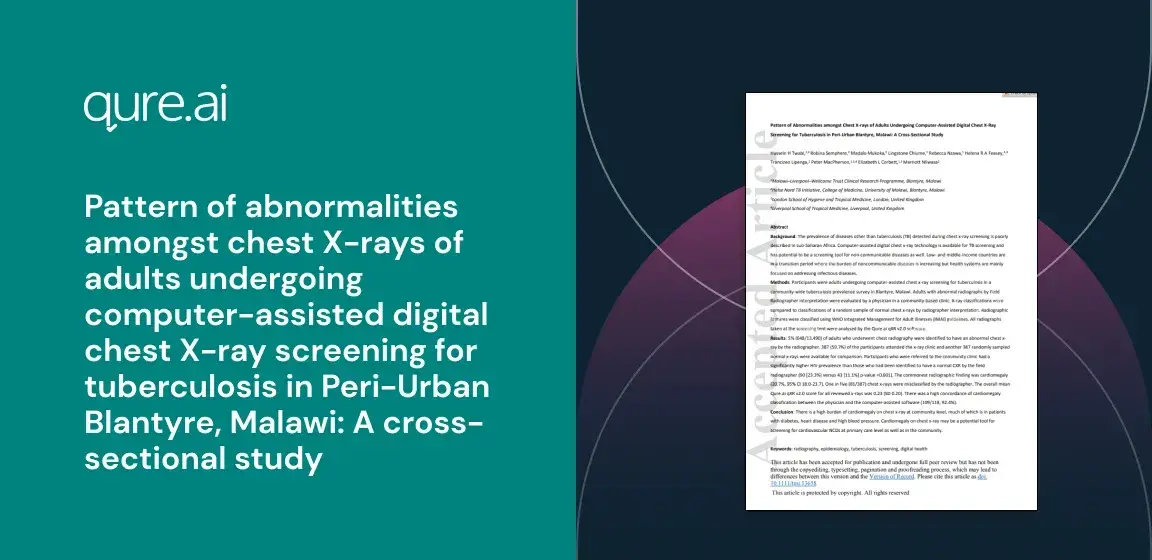Background
Published 23 Jul 2021
Pattern of abnormalities amongst chest X-rays of adults undergoing computer-assisted digital chest X-ray screening for tuberculosis in Peri-Urban Blantyre, Malawi: A cross-sectional study
Author: Hussein H. Twabi1,2, Robina Semphere2, Madalo Mukoka2, Lingstone Chiume1, Rebecca Nzawa1, Helena R. A. Feasey1,3, Trancizeo Lipenga2, Peter MacPherson1,3,4, Elizabeth L. Corbett1,3, and Marriott Nliwasa2 1

Back
The prevalence of diseases other than tuberculosis (TB) detected during chest X-ray screening is poorly described in sub-Saharan Africa. Computer-assisted digital chest X-ray technology is available for TB screening and has the potential to be a screening tool for non-communicable diseases as well. Low- and middle-income countries are in a transition period where the burden of non-communicable diseases is increasing, but health systems are mainly focused on addressing infectious diseases.
Methods
Participants were adults undergoing computer-assisted chest X-ray screening for tuberculosis in a community-wide tuberculosis prevalence survey in Blantyre, Malawi. Adults with abnormal radiographs by field radiographer interpretation were evaluated by a physician in a community-based clinic. X-ray classifications were compared to classifications of a random sample of normal chest X-rays by radiographer interpretation. Radiographic features were classified using WHO Integrated Management for Adult Illnesses (IMAI) guidelines. All radiographs taken at the screening tent were analysed by the Qure.ai qXR v2.0 software.
Results
5% (648/13,490) of adults who underwent chest radiography were identified to have an abnormal chest X-ray by the radiographer. 387 (59.7%) of the participants attended the X-ray clinic, and another 387 randomly sampled normal X-rays were available for comparison. Participants who were referred to the community clinic had a significantly higher HIV prevalence than those who had been identified to have a normal CXR by the field radiographer (90 [23.3%] vs. 43 [11.1%] p-value < 0.001). The commonest radiographic finding was cardiomegaly (20.7%, 95% CI 18.0–23.7). One in five (81/387) chest X-rays were misclassified by the radiographer. The overall mean Qure.ai qXR v2.0 score for all reviewed X-rays was 0.23 (SD 0.20). There was a high concordance of cardiomegaly classification between the physician and the computer-assisted software (109/118, 92.4%).
Conclusion
There is a high burden of cardiomegaly on a chest X-ray at a community level, much of which is in patients with diabetes, heart disease and high blood pressure. Cardiomegaly on chest X-ray may be a potential tool for screening for cardiovascular NCDs at the primary care level as well as in the community.
Authors
Hussein H. Twabi1,2, Robina Semphere2, Madalo Mukoka2, Lingstone Chiume1, Rebecca Nzawa1, Helena R. A. Feasey1,3, Trancizeo Lipenga2, Peter MacPherson1,3,4, Elizabeth L. Corbett1,3, and Marriott Nliwasa2 1
Citation
1. Malawi– Liverpool– Wellcome Trust Clinical Research Programme 2. Blantyre 3. Malawi College of Medicine 4. Helse Nord TB Initiative 5. University of Malawi 6. Blantyre 7. Malawi London School of Hygiene and Tropical Medicine 8. London 9. UK Liverpool School of Tropical Medicine 10. Liverpool 11. UK